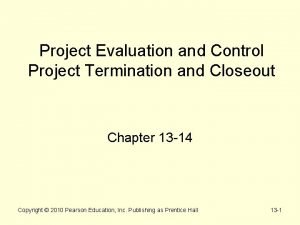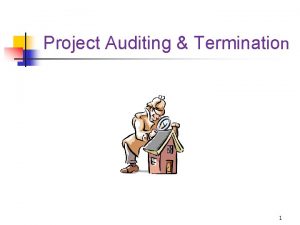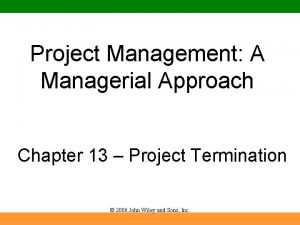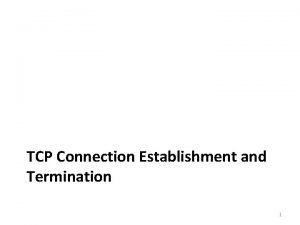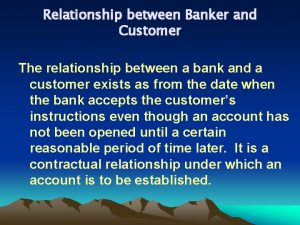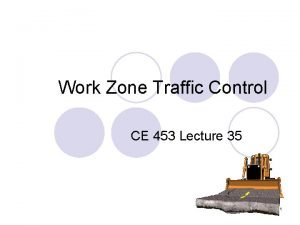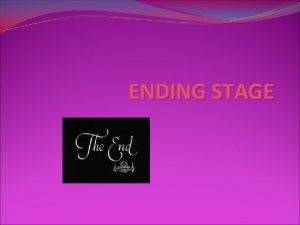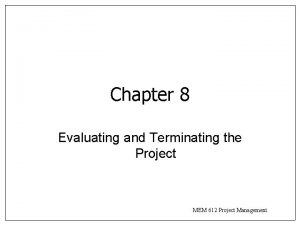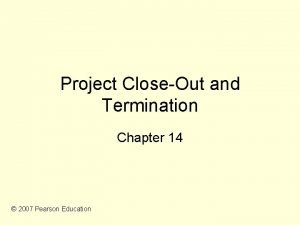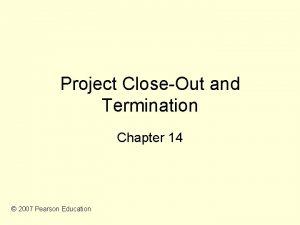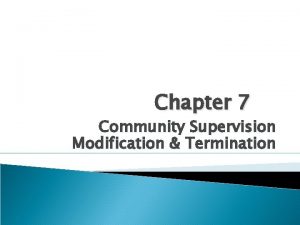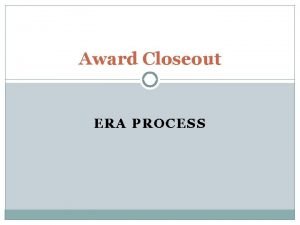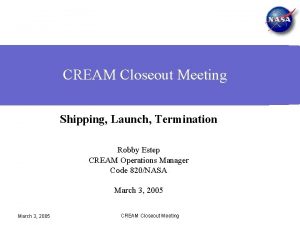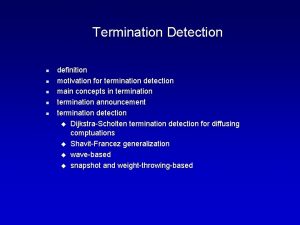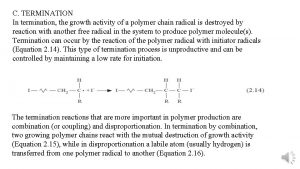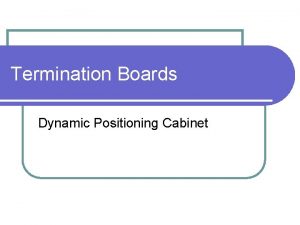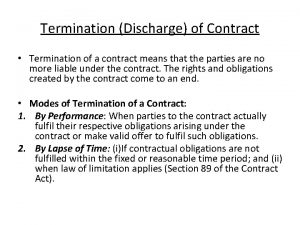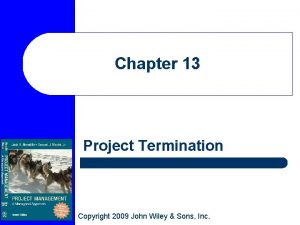PROJECT CLOSEOUT AND TERMINATION Chapter 14 Copyright 2016






















- Slides: 22

PROJECT CLOSEOUT AND TERMINATION Chapter 14 Copyright © 2016 Pearson Education, Inc.

CHAPTER 14 LEARNING OBJECTIVES After completing this chapter, you should be able to: 1. Distinguish among the four main forms of project management. 2. Recognize the seven steps in formal project closeout. 3. Understand key reasons for early termination of projects. 4. Know the challenges and components of a final project report. Copyright © 2016 Pearson Education, Inc. 14 -2

PMBOK CORE CONCEPTS Project Management Body of Knowledge (PMBOK) covered in this chapter includes: 1. Close Project (PMBo. K 4. 6) 2. Close Procurements (PMBo. K 12. 4) Copyright © 2016 Pearson Education, Inc. 14 -3

PROJECT TERMINATION The four main reasons for project termination are: v. Extinction v. Addition v. Integration v. Starvation Copyright © 2016 Pearson Education, Inc. 14 -4

NATURAL TERMINATIONCLOSEOUT PROCESS Finishing the Work Handing Over the Project Private Finance Initiatives (PFIs) Build, Operate, and Transfer (BOT) Build, Own, Operate, and Transfer (BOOT) Gaining Acceptance for the Project Harvesting the Benefits Reviewing How It All Went Copyright © 2016 Pearson Education, Inc. 14 -5

POST PROJECT REVIEWS 1. Objectivity and Issues a. b. c. d. Outside reviewers are unfamiliar. Project team may be suspicious. Outside evaluators may be compelled to find problems. Outside reviewers are not competent. 2. Internal Consistency 3. Replicability 4. Fairness Copyright © 2016 Pearson Education, Inc. 14 -6

LESSONS LEARNED MEETINGS Common Errors ØMisidentifying systematic errors ØMisapplying or misinterpreting lessons based on events ØFailure to pass along conclusions Meeting Guidelines üEstablish clear rules of behavior üDescribe objectively what occurred üFix the problem, not the blame Copyright © 2016 Pearson Education, Inc. 14 -7

CLOSEOUT PAPERWORK Documentation Legal Cost Personnel Copyright © 2016 Pearson Education, Inc. 14 -8

REQUIRED REVIEWS General program and project management confidence Commercial confidence Market and sales confidence Product quality confidence Manufacturing confidence Supply chain logistics confidence Aftermarket confidence Health, safety, and environment confidence Copyright © 2016 Pearson Education, Inc. 14 -9

WHAT PREVENTS EFFECTIVE PROJECT CLOSEOUTS? üProject sign off discourages other closeout activities. üUrgency of all project pressures cause shortcuts on backend. üLow priority given to closeout activities. üLessons learned analysis seen as bookkeeping. üUnique view of projects. Copyright © 2016 Pearson Education, Inc. 14 -10

DYNAMIC FACTORS TO MONITOR 1. Static 2. Task-team 3. Sponsorship 4. Economics 5. Environment 6. User Copyright © 2016 Pearson Education, Inc. 14 -11

EARLY TERMINATION DECISION RULES 1. Costs exceed business benefits. 2. Failure to meet strategic fit criteria. 3. Deadlines continue to be missed. 4. Technology evolves beyond the project’s scope. Copyright © 2016 Pearson Education, Inc. 14 -12

PROJECT TERMINATION ISSUES Emotional Staff Client Intellectual Internal External Figure 14. 3 Copyright © 2016 Pearson Education, Inc. 14 -13

CONCERNS WHEN SHUTTING DOWN A PROJECT Emotional Issues of the Project Team Emotional Issues of the Clients Intellectual Issues-Internal Intellectual Issues-External Copyright © 2016 Pearson Education, Inc. 14 -14

PROJECT TERMINATION ISSUES – EMOTIONAL (TABLE 14. 2) Emotional Project Team Fear of no future work Client Change in attitude Loss of interest in remaining tasks Loss of interest in project Loss of project-derived motivation Change in personnel dealing with project Loss of team identity Unavailability of key personnel Selection of personnel to be reassigned Diversion of effort Copyright © 2016 Pearson Education, Inc. 14 -15

PROJECT TERMINATION ISSUES – INTELLECTUAL (TABLE 14. 2) Intellectual Internal External Identification of remaining deliverables Agreement with client on remaining deliverables Certification needs Agreement with suppliers on outstanding commitments Identification of outstanding commitments Communicating closure Control of changes to project Closing down facilities Screening of partially completed tasks Determination of requirements for audit trail data Closure of work orders and work packages Disposal of unused material Copyright © 2016 Pearson Education, Inc. 14 -16

TOP 10 SIGNS OF IT PROJECT FAILURE 1. Best practices and lessons learned are ignored. 2. Project lacks people with appropriate skills. 3. Sponsorship is lost. 4. Users are resistant. 5. Deadlines are unrealistic. 6. Business needs change. 7. Chosen technology changes. 8. Project changes are poorly managed. 9. Scope is ill-defined. 10. Project managers don’t understand users’ needs. Copyright © 2016 Pearson Education, Inc. 14 -17

CLAIMS & DISPUTES Two types of claims: Ex-gratia claims Default by the project company Resolved by: Arbitration Binding Non-binding Standard litigation Copyright © 2016 Pearson Education, Inc. 14 -18

PROTECTING AGAINST CLAIMS üConsider claims as part of the project plan. üVerify stakeholders know their risks. üKeep good records throughout the life cycle. üKeep clear details of change orders. üArchive all correspondence. Copyright © 2016 Pearson Education, Inc. 14 -19

FINAL REPORT ELEMENTS 1. Project performance 2. Administrative performance 3. Organizational structure 4. Team performance 5. Project management techniques 6. Benefits to the organization and customer Copyright © 2016 Pearson Education, Inc. 14 -20

SUMMARY 1. Distinguish among the four main forms of project management. 2. Recognize the seven steps in formal project closeout. 3. Understand key reasons for early termination of projects. 4. Know the challenges and components of a final project report. Copyright © 2016 Pearson Education, Inc. 14 -21

Copyright © 2016 Pearson Education, Inc. 14 -22
 Project termination steps
Project termination steps Project closeout presentation
Project closeout presentation Putting it all to bed during project closeout includes
Putting it all to bed during project closeout includes Project termination types
Project termination types Contract closeout
Contract closeout Quick closeout
Quick closeout Transfer of command
Transfer of command Demobilization planning helps to
Demobilization planning helps to Define project termination
Define project termination Project termination by extinction
Project termination by extinction Project termination
Project termination Tcp establishment and termination
Tcp establishment and termination Is responsible for all file i/o initiation and termination
Is responsible for all file i/o initiation and termination Banker customer relationship
Banker customer relationship Project compassion 2016
Project compassion 2016 Termination area mutcd
Termination area mutcd Termination of treaties
Termination of treaties Wawancara klinis
Wawancara klinis Voluntary termination
Voluntary termination Unplanned termination of members from a group
Unplanned termination of members from a group Femoral canal and femoral sheath
Femoral canal and femoral sheath Evaluation of termination possibilities
Evaluation of termination possibilities Termination transtheoretical model
Termination transtheoretical model


